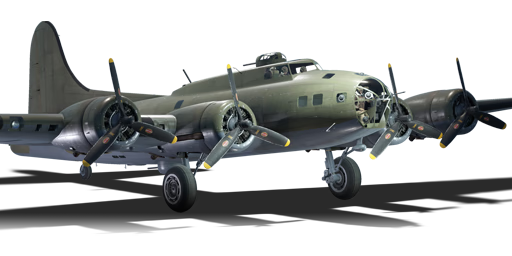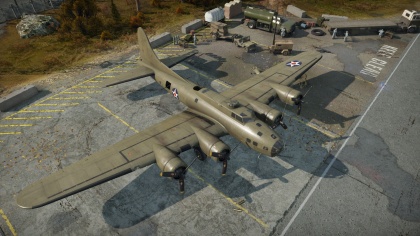B-17E
Contents
| This page is about the aircraft B-17E. For other uses, see B-17 (Family). |
Description
The B-17E Flying Fortress is a rank American heavy bomber bomber
with a battle rating of (AB), (RB), and (SB). This bomber has been in the game since the start of the Open Beta Test prior to Update 1.27.
General info
Flight Performance
Describe how the aircraft behaves in the air. Speed, manoeuvrability, acceleration and allowable loads - these are the most important characteristics of the vehicle.
| Characteristics | |||||||
|---|---|---|---|---|---|---|---|
| Stock | |||||||
| Max Speed (km/h at 7,680 m) |
Max altitude (meters) |
Turn time (seconds) |
Rate of climb (meters/second) |
Take-off run (meters) | |||
| AB | RB | AB | RB | AB | RB | ||
| 497 | 483 | 36.9 | 37.9 | 5.8 | 5.6 | 600 | |
| Upgraded | |||||||
| Max Speed (km/h at 7,680 m) |
Max altitude (meters) | Turn time (seconds) | Rate of climb (meters/second) |
Take-off run (meters) | |||
| AB | RB | AB | RB | AB | RB | ||
| 525 | 512 | 33.7 | 33.8 | 10.6 | 8.6 | 600 | |
Details
| Features | ||||
|---|---|---|---|---|
| Combat flap | Take-off flap | Landing flap | Air brakes | Arrestor gear |
| ✓ | ✓ | ✓ | X | X |
| Limits | ||||
|---|---|---|---|---|
| Wing-break speed (km/h) |
Gear limit (km/h) |
Combat flap (km/h) |
Max Static G | |
| + | - | |||
| 400 | ~1 | ~1 | ||
| Optimal velocities | |||
|---|---|---|---|
| Ailerons (km/h) |
Rudder (km/h) |
Elevators (km/h) |
Radiator (km/h) |
| < 360 | < 300 | < 323 | > 210 |
| Compressor (RB/SB) | ||
|---|---|---|
| Setting 1 | ||
| Optimal altitude | 100% Engine power | WEP Engine power |
| 6,180 m | 4,000 hp | 4,708 hp |
Survivability and armour
- 6.35 mm Steel plate behind nose gunner.
- 6.35 mm Steel plates behind pilots.
- 6.35 mm Steel plates behind dorsal gunners.
- 6.35 mm Steel plates in front of beam gunners.
- 6.35 mm Steel plates in front of tail gunner.
- 38 mm Bulletproof glass in front of tail gunner.
- 38 mm Bulletproof glass ball turret.
Armaments
Suspended armament
The B-17E can be outfitted with the following ordinance:
- 8 x 500 lb AN-M64A1 bombs (4,000 lb total)
- 12 x 500 lb AN-M64A1 bombs (6,000 lb total)
- 6 x 1000 lb AN-M65A1 bombs (6,000 lb total)
- 2 x 2000 lb AN-M66A2 bombs (4,000 lb total)
Defensive armament
The B-17E is defended by:
- 1 x 7.62 mm Browning machine gun, nose turret (500 rpg)
- 2 x 12.7 mm M2 Browning machine gun, front dorsal turret (500 rpg = 1,000 total)
- 1 x 12.7 mm M2 Browning machine gun, rear dorsal turret (500 rpg)
- 1 x 12.7 mm M2 Browning machine gun, 2 x beam turret (400 rpg = 800 total)
- 2 x 12.7 mm M2 Browning machine gun, ventral turret (500 rpg = 1,000 total)
- 2 x 12.7 mm M2 Browning machine gun, tail turret (500 rpg = 1,000 total)
Usage in battles
The B-17E Flying Fortress is intended to be used as a high-altitude level bomber in order to target airfields, bases, and land fortifications. Despite its large bomb load, it's not recommended to target moving ground units, such as tanks or armored cars, especially when they are travelling in tight columns due to the inaccuracy of your bombs at high altitudes and the ability for the AI on the ground to perform evasive manoeuvres when bombs are falling onto their position. When using the B-17E, it is best to fly with another friendly bomber or fighter (if possible) to ensure maximum protection. If you are flying alone, design a secure flight path towards your objective in hopes of not being detected by enemy fighters.
The B-17E is designed specifically to withstand the harshest punishment during combat. The bomber itself provides plenty of armour along the fuselage and tail except for the nose, which is the only area that's not protected by any form of protection. Armour ranges from 6.35 mm sheets to a single 38 mm glass plate protecting the tail gunner. Speaking of armour protection, in order to ensure the greatest chance of survival during an interception, you must not move. The B-17E is not designed to execute sharp defensive manoeuvres (turns, dives, and rolls), but rather designed to use its defensive armament provided (consisting of 12.7 mm and 7.62 mm turrets) to fight back against harassing enemy fighters. Some great advice for novice bombardiers is to included incendiary ammunition in your turret belts almost ALWAYS! This crucial precaution will guarantee more lethal firepower coming from your defensive armament, since not only are you penetrating armour, but you are also setting components ablaze.
In conclusion, the B-17E is a great introduction for players using the American bomber line. If used well, the B-17E is a force be reckoned with.
Manual Engine Control
| MEC elements | ||||||
|---|---|---|---|---|---|---|
| Mixer | Pitch | Radiator | Supercharger | Turbocharger | ||
| Oil | Water | Type | ||||
| Controllable | Controllable | Not controllable | Controllable | Combined | Controllable | Not controllable |
Modules
As a slow and lumbering heavy bomber the Flying Fortress relies entirely on its turrets for defence. Without it, the plane is a pinata. Thus Protective vests should be the first unlock. Further survivability upgrades will make fending of attacks easier but do not think to stand successfully against enemy fighters. So upgrading the bomb load should be second priority. Performance modules can be considered least necessary, it will not go anywhere quick anyway.
| Tier | Flight performance | Survivability | Weaponry | ||
|---|---|---|---|---|---|
| I | Fuselage Repair | Radiator | Turret 7 mm | ||
| II | Compressor | Airframe | New 7 mm MGs (turret) | LBC-17 | |
| III | Wings Repair | Engine | Turret 12 mm | SBC-17 | |
| IV | Engine Injection | Cover | New 12 mm MGs (turret) | MBC-17 | |
Pros and cons
Pros:
- Large bomb load
- Heavy defensive armament
- Multiple engines (preserves speed when damaged)
- Very sturdy fuselage able to soak up heavy damage
- Calibers below 12.7 mm are ineffective against it
- Good speed
- Defensive armaments provide all-around coverage
- Performs well at high altitudes
Cons:
- Cumbersome target
- Poor climb rate
- Nose is extremely vulnerable
- Cannons are very effective against it
- Multiple engines mean multiple fires
- Sluggish controls and very difficult to manoeuvre
- Wings are large and vulnerable
- Low speed
- Weak against 20 mm cannons
History
Describe the history of the creation and combat usage of the aircraft in more detail than in the introduction. If the historical reference turns out to be too big, take it to a separate article, taking a link to the article about the vehicle and adding a block "/ History" (example: https://wiki.warthunder.com/(Vehicle-name)/History) and add a link to it here using the main template. Be sure to reference text and sources by using <ref>, as well as adding them at the end of the article. This section may also include the vehicle's dev blog entry (if applicable) and the in-game encyclopedia description (under === Encyclopedia Info ===, also if applicable).
OPERATIONAL HISTORY
he B-17 began operations in World War II with the Royal Air Force (RAF) in 1941, and in the Southwest Pacific with the U.S. Army. The 19th Bombardment Group had deployed to Clark Field in the Philippines a few weeks before the Japanese attack on Pearl Harbor as the first of a planned heavy bomber buildup in the Pacific. Half of the group's B-17s were wiped out on 8 December 1941 when they were caught on the ground during refueling and rearming for a planned attack on Japanese airfields on Formosa. The small force of B-17s operated against the Japanese invasion force until they were withdrawn to Darwin, in Australia's Northern Territory. In early 1942, the 7th Bombardment Group began arriving in Java with a mixed force of B-17s and LB-30/B-24s. A squadron of B-17s from this force detached to the Middle East to join the First Provisional Bombardment Group, thus becoming the first American B-17 squadron to go to war against the Germans. After the defeat in Java, the 19th withdrew to Australia, where it continued in combat until it was sent home by General George C. Kenney when he arrived in Australia in mid-1942. In July 1942, the first USAAF B-17s were sent to England to join the Eighth Air Force. Later that year, two groups moved to Algeria to join Twelfth Air Force for operations in North Africa. The B-17s were primarily involved in the daylight precision strategic bombing campaign against German targets ranging from U-boat pens, docks, warehouses, and airfields to industrial targets such as aircraft factories. In the campaign against German aircraft forces in preparation for the invasion of France, B-17 and B-24 raids were directed against German aircraft production while their presence drew the Luftwaffe fighters into battle with Allied fighters.
During World War II, the B-17 equipped 32 overseas combat groups, inventory peaking in August 1944 at 4,574 USAAF aircraft worldwide. The British heavy bombers, the Avro Lancaster and Handley Page Halifax, dropped 608,612 long tons (681,645 short tons) and 224,207 long tons (251,112 short tons) respectively.
In-game description
"The legendary B-17 American heavy bombers were rightly called Flying Fortresses. This four-engined heavy bomber was an all-metal hero, an extremely durable aircraft that could return to the airfield with just one engine, riddled with bullets.
But the early models of the B-17 had a significant blind spot in the rear, so fighter support was required. To solve this problem, the B-17E was produced, and a turret with two 12.7mm machine guns was installed in the tail section of the aircraft. To do this, the fuselage size had to be increased. In addition, to improve control of the plane, the tail was broadened and a larger vertical fin was installed.
Although it lost some speed when compared to the B-17D, the new model fared favorably with its new protection and thus became the first truly mass-produced B-17. From September 5, 1941 to May 1942, 512 aircraft were made on the production line, before the development of the B-17F. "
Media
Excellent additions to the article would be video guides, screenshots from the game, and photos.
See also
Links to the articles on the War Thunder Wiki that you think will be useful for the reader, for example:
- reference to the series of the aircraft;
- links to approximate analogues of other nations and research trees.
External links
Paste links to sources and external resources, such as:
- topic on the official game forum;
- encyclopedia page on the aircraft;
- other literature.
| USA bombers | |
|---|---|
| Dive | SB2U-2 · SB2U-3 · SBD-3 · SB2C-1C · SB2C-4 |
| Torpedo | TBD-1 · PBY-5 Catalina · PBY-5A Catalina · TBF-1C · BTD-1 |
| Medium | B-10B · B-18A · B-34 · PV-2D · B-25J-1 · B-25J-20 · A-26C-45 · A-26C-45DT · B-26B |
| Heavy | B-17E · B-17E/L · B-17G-60-VE · PB4Y-2 · B-24D-25-CO · B-29A-BN |
| Hydroplanes | OS2U-1 · OS2U-3 · PBM-1 "Mariner" · PBM-3 "Mariner" · PBM-5A "Mariner" |





